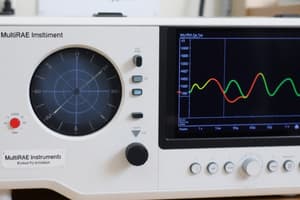Podcast
Questions and Answers
What is the primary function of a multirange ammeter?
What is the primary function of a multirange ammeter?
To measure a wide range of currents with a single instrument
What feature allows a multirange ammeter to measure different current ranges?
What feature allows a multirange ammeter to measure different current ranges?
Multiple scales or ranges on the dial and a selector switch to choose the desired range
What are the advantages of using a multirange ammeter?
What are the advantages of using a multirange ammeter?
Convenience, space-saving, and cost-effective
In which type of applications is a multirange ammeter commonly used?
In which type of applications is a multirange ammeter commonly used?
What additional features may be found in a multirange ammeter?
What additional features may be found in a multirange ammeter?
Flashcards are hidden until you start studying
Study Notes
Multirange Ammeter: General
Definition
A multirange ammeter is a type of ammeter that can measure a wide range of currents with a single instrument.
Key Features
- Can measure currents in multiple ranges (e.g., 0-10mA, 0-100mA, 0-1A, etc.)
- Typically has multiple scales or ranges on the dial
- Often has a selector switch to choose the desired range
- May have additional features such as overload protection, zero-adjustment, and calibration facilities
Advantages
- Convenience: measures a wide range of currents with a single instrument
- Space-saving: eliminates the need for multiple ammeters
- Cost-effective: reduces the need for multiple ammeters
Applications
- Electrical testing and measurement
- Laboratory work
- Industrial applications
- Educational institutions
Multirange Ammeter
- A multirange ammeter is a versatile instrument that measures a wide range of currents.
Definition
- It's a type of ammeter that can measure multiple current ranges with a single instrument.
Key Features
- Measures currents in multiple ranges (e.g., 0-10mA, 0-100mA, 0-1A, etc.)
- Typically features multiple scales or ranges on the dial.
- Often equipped with a selector switch to choose the desired range.
- May include additional features such as overload protection, zero-adjustment, and calibration facilities.
Advantages
- Convenient: measures a wide range of currents with a single instrument.
- Space-saving: eliminates the need for multiple ammeters.
- Cost-effective: reduces the need for multiple ammeters.
Applications
- Used in electrical testing and measurement.
- Utilized in laboratory work.
- Implemented in industrial applications.
- Employed in educational institutions.
Studying That Suits You
Use AI to generate personalized quizzes and flashcards to suit your learning preferences.




